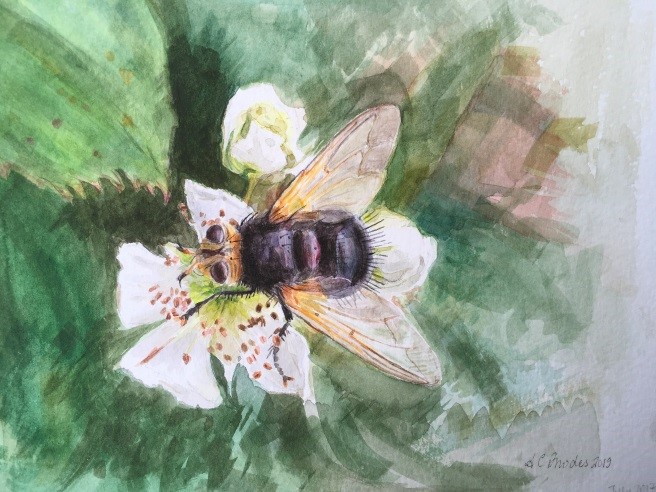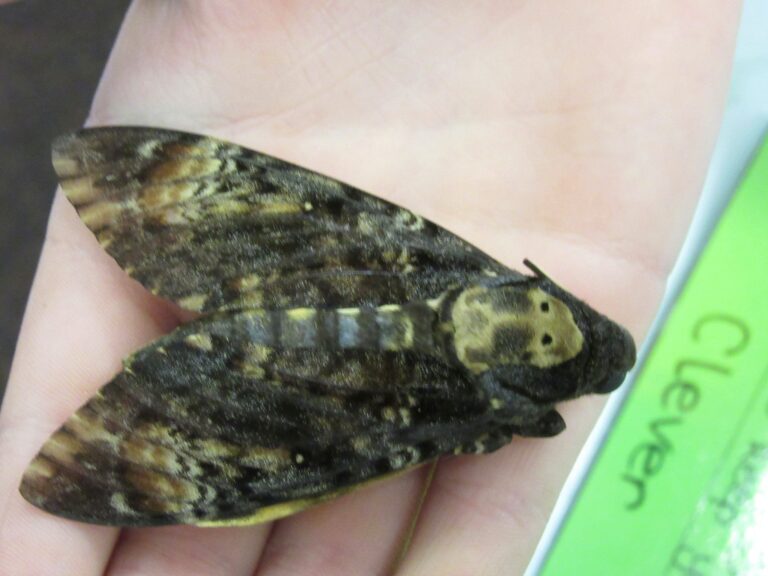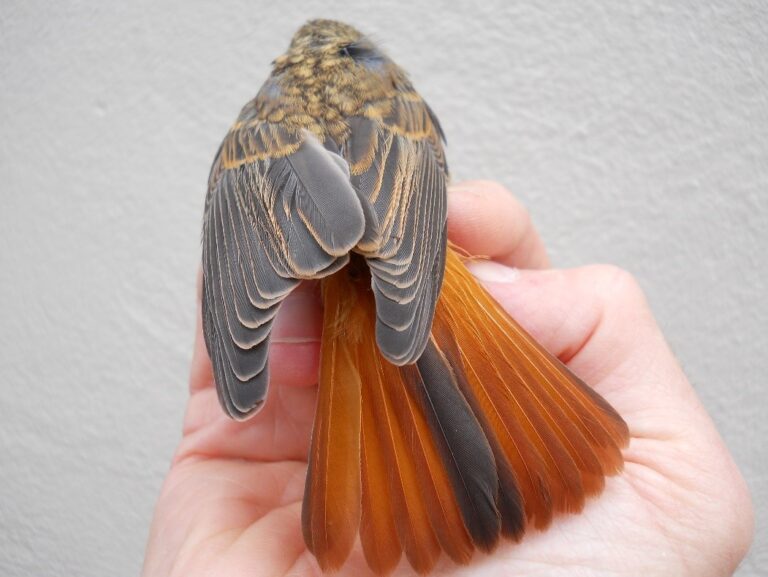An article by the late Abby Rhodes.

My first encounters with flies must have been at an age where I was able to fire a ‘laggy band’ at the poor creatures in the kitchen, splatting them on walls and ceiling, encouraged by my competitive father.
The days when in summer the house was full of the common housefly, Musca domestica and you could travel by car for several hours but then had to stop to clear the windscreen of ‘bug splat’ are now a vague memory. Being close to the ground as you are when you are little, brings you closer to creepy crawlies and nurtures the love of exploration. Unfortunately for the flies, my empathy was undeveloped and I would catch them, demobilise them by removing a wing and then frazzle the poor things with a magnifying glass (This was recently confirmed by our neighbour, Pippa with whom I have linked up with on Facebook).
Perhaps it was my morbid curiosity which sowed the seed. Well my father sorted out my lack of empathy with “just imagine a great big shoe coming down on top of you and squashing you dead; how would you like it?”. That did the trick!
We moved to Sutherland, in 2010 having bought a traditional style croft house the year before. This was going to be a new life for my husband Gary and me. I was interested in doing some voluntary conservation work so I booked myself on a bird surveying course with the British Trust for Ornithology and began doing some survey work such as breeding bird surveys and Wetland Bird Survey. This, however, was not hands-on enough and I soon realised that getting up in the early hours to traipse around bleak heathland to count the predictable species was not for me. I did however like the idea of ringing birds so when I finally found a trainer fairly close-by, in 2012, I started to train to be a ringer. The training was very intense since neither my trainer nor I worked, so we could ring on most days when the weather permitted. May and June were busy months with the nestlings but by July/ August I was kicking my heels not knowing where to focus my exploration needs.
Our croft house at Dalcharn was surrounded by garden and on two sides by croft land. The croft land was unsuitable for crops but provided grazing for sheep at certain times of the year. The land to one side slopes down to a wooded area, then to a burn. Many species of plants can be found here such as bog asphodel, marsh marigolds, globe flower, orchids, hard heads and trees such as alder, willow, birch and rowan which over time had been grazed and ‘bonsaied’ by sheep. This was such a perfect place for pollinators and is where my short interest in bees developed into an interest in hoverflies. Bees would never sit still long enough to get a good photograph and I wasn’t knowledgeable enough to know how to catch them and study them properly. Hoverflies did tend to ‘sit’ still on flowers and leaves and that is where my interest got kick- started properly. Every spare moment I would either be in the garden or down in the field. It had to be sunny, when most of the insects are visible, feeding on pollen and basking in the sun’s warmth. It was also better for photography.
My old Nikon was replaced by a newer model and I found a FaceBook group called UK Hoverflies – so joined. The group was headed by Roger Morris who was always happy to help with identification. There comes a time at the end of summer when ‘hovers’ become few and far between and at this point I turned my efforts to their relatives. I remember describing what I thought was a type of dung fly (Scathophagid) to Roger who conveyed this to Stuart Ball (Scathophagidae Recording Scheme) and was asked to catch a specimen if I came across another one. I was advised to put it in the freezer for a couple of hours to humanely kill it. I never did find that specimen but Preston Montford (Field Studies Council) courses with Roger Morris and Stuart Ball really got me going with the flies. I came away knowing what equipment I needed to identify the flies and proceeded to purchase a microscope, nets, pins, tubes etc. I also came away with a wealth of information including keys – Stuart Ball’s key to fly families which we received on the course ‘Introduction to Fly Families’ I still use to this day.
One of the most difficult pre-requisites for identifying flies is, in my opinion, knowing the morphology. This is further complicated by use of different terms in different keys, but once you have collected the different morphological diagrams it becomes easier. Another difficult learning curve for me was determining bristle position on the legs. My husband created a visual aid to help with this. (Figure 2a) Not only are the bristle positions around the circumference of the legs important but also along the length of each leg segment.


I would certainly advise anyone who is interested in identifying flies to begin with sorting flies into families using a key. There are around 150,000 different kinds of flies worldwide (‘only’ about 7000 in Britain, in 103 families. Ed.) and many are very similar so guessing will often prove to be fruitless. When I started on the ID route I would just catch several flies individually, usually straight into a glass pot. Sweep netting tended to overwhelm me. The flies would be humanely killed, pinned, labelled with date, place or grid reference and if necessary the legs would be pulled into position for easy viewing of important structures and bristles. The proboscis is teased out to reveal its length and the palps. In some families such as the Anthomyiidae, the genitalia are made visible as this is an important identification tool.
This is the point at which Abby’s draft for the article finished. An editorial decision was made to include it as it stands, since Abby had taken the trouble to work on it in her last months. The Anthomyiidae, mentioned in the last sentence of her text, is a difficult group. Murdo Macdonald noted that Abby showed a particular facility for recognising them in the field and identifying the specimens later. It was a skill which few people have in a rather difficult fly family. Her collections and records will be found a suitable home, in accordance with her wishes.
Bibliography (Diptera)
Rhodes, A. & Macdonald, M., 2018. Occurrence of Stomorhina lunata (Fabricius)(Diptera, Rhiniidae) in north Scotland. Dipterists’ Digest, 25(1);59-61.
Rhodes, A. & Brighton, P., 2018. Emergence of Lasiomma picipes (Meigen) (Diptera, Anthomyiidae) from Golden eagle pellets. Dipterists’ Digest, 25(2): 139-141.
Abby Rhodes was a founding member of the wildlife group. This article was first published in April 2019 in The Highland Naturalist, the in-house magazine of The Highland Biological Recording Group. Thank you to Stephen Moran for making this available to us.






